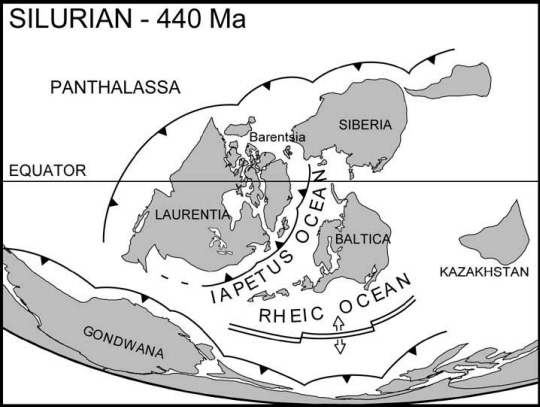The Pangea problem

A paper in the journal Geology described the problem plate tectonics theory has with itself in assembling the supercontinent Pangea. Here are excerpts.
"Although the existence of Pangea is one of the cornerstones of geology, the mechanisms responsible for its amalgamation are poorly understood."

"The formation of Pangea is primarly recorded in the origin and evolution of the Paleozoic oceans (Iapetus, Rheic, Prototethys) between Laurentia (ancestral North America), Baltica (northwestern Europe), and northern Gondwana (South America-West Africa)." These oceans had to close for the various parts to come together to make Pangea.
"There is a broad consensus that sinking of cold lithosphere (slab pull) provides 90% of the force needed to drive plate tectonics and is indirectly responsible for upwelling beneath mid-ocean ridges." "However, if these geodynamic arguments are applied to the early Paleozoic, they fail to predict the formation of Pangea in the correct configuration."
Subduction in the
wrong direction
"By the early Paleozoic, Laurentia,
Baltica, and Gondwana had separated, resulting in the opening of
the Iapetus and Rheic Oceans." "However,... the
dispersing continents should have migrated toward the subduction
zones in the exterior paleo-Pacific Ocean [Panthalassa], and it
is this ocean that should have closed. Instead, a wealth of
geologic evidence indicates that subduction commenced in the relatively
newly formed interior (Iapetus and Rheic) oceans located between
Laurentia, Baltica, and Gondwana, and that Pangea assembled as the
interior ocean closed."
"Subduction in the paleo-Pacific Ocean [Panthalassa] was clearly well established ~80 million years before subduction commenced in the Iapetus Ocean and before the Rheic Ocean opened." "Slab pull forces associated with this subduction should have resulted in the migration of the dispersing continents toward the paleo-Pacific subduction zones." "However, this motion reversed itself when subduction commenced in the relatively newly formed Iapetus and Rheic Oceans between Laurentia, Baltica, and Gondwana." "Therefore, subduction was not only initiated within the new interior oceans, but the rates of subduction of this relatively young Paleozoic lithosphere must also have overpowered those of the already well-established subduction zones within the exterior (paleo-Pacific) [Panthalassa] ocean."
Next problem: initiating
subduction
"A key problem that needs to be addressed
in resolving this conundrum is the geodynamic scenario that facilitated
the initiation of subduction in the Iapetus and Rheic Oceans and
generated sufficient slab pull to drive the dispersing continental
fragments toward the Pangea configuration. Subduction initiation
is controversial, although it is generally accepted that initiation
at passive margins is mechanically difficult because of the flexural
rigidity of the oceanic lithosphere. No simple modern analogues
for such a process have been documented." They speculate
that compression across old transform faults started subduction,
although the source of compression and why these and not other transform
faults subducted is not addressed.
But the new subduction
is too weak
Even so, "subduction zones initiated in
this manner cannot pull the large overriding plates toward them,
and so cannot be considered a mechanism that began the assembly
of Pangea."
They are forced
to resort to mantle plumes.
"This conundrum suggests
that top-down [plate tectonic] geodynamic forces can be overridden
by other forces. Assuming that continents migrate from geoid
highs to geoid lows, the reversal of their movement in the middle
Paleozoic implies that the geoid lows became geoid highs. The
mechanisms for this are unclear. However, one possibility
is that the descent of subducted slabs in the paleo-Pacific [Panthalassa]
Ocean to the core-mantle boundary thermally insulated that boundary,
leading to the ponding of hot mantle material that built up and
rose toward the surface as a superplume." "Such
an event would result in a geoid high and enhanced seafloor spreading
in the paleo-Pacific [Panthalassa] Ocean that could have been responsible
for the reversal in the direction of motion of the continents."
"An Ordovician superplume has been proposed... to account
for the period's high sea levels, high paleotemperatures, abundant
black shales, and strong biological activity."
The idea of mantle plumes, once almost universally accepted, has become controversial. See www.mantleplumes.org
Murphy, J. Brendan, R. Damian Nance. September 2008. The Pangea conundrum. Geology, Vol. 36, No. 9, pp. 703-706.
John Michael Fischer, 2008
www.newgeology.us